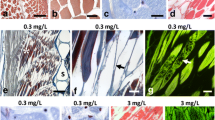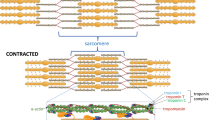Abstract
Titin (also known as connectin) is a striated-muscle-specific protein that spans the distance between the Z- and M-lines of the sarcomere. The elastic segment of the titin molecule in the I-band is thought to be responsible for developing passive tension and for maintaining the central position of thick filaments in contracting sarcomeres. Different muscle types express isoforms of titin that differ in their molecular mass. To help to elucidate the relation between the occurrence of titin isoforms and the functional properties of different fibre types, we investigated the presence of different titin isoforms in red and white fibres of the axial muscles of carp. Gel electrophoresis of single fibres revealed that the molecular mass of titin was larger in red than in white fibres. Fibres from anterior and posterior axial muscles were also compared. For both white and red fibres the molecular mass of titin in posterior muscle fibres was larger than in anterior muscle fibres. Thus, the same fibre type can express different titin isoforms depending on its location along the body axis. The contribution of titin to passive tension and stiffness of red anterior and posterior fibres was also determined. Single fibres were skinned and the sarcomere length dependencies of passive tension and passive stiffness were determined. Measurements were made before and after extracting thin and thick filaments using relaxing solutions with 0.6 mol · l−1 KCl and 1 mol · l−1 KI. Tension and stiffness measured before extraction were assumed to result from both titin and intermediate filaments, and tension after extraction from only intermediate filaments. Compared to mammalian skeletal muscle, intermediate filaments developed high levels of tension and stiffness in both posterior and anterior fibres. The passive tension-sarcomere length curve of titin increased more steeply in red anterior fibres than in red posterior fibres and the curve reached a plateau at a shorter sarcomere length. Thus, the smaller titin isoform of anterior fibres results in more passive tension and stiffness for a given sarcomere strain. During continuous swimming, red fibres are exposed to larger changes in sarcomere strain than white fibres, and posterior fibres to larger changes in strain than anterior fibres. We propose that sarcomere strain is one of the functional parameters that modulates the expression of different titin isoforms in axial muscle fibres of carp.
Similar content being viewed by others
Author information
Authors and Affiliations
Additional information
Accepted: 7 May 1997
Rights and permissions
About this article
Cite this article
Spierts, I., Akster, H. & Granzier, H. Expression of titin isoforms in red and white muscle fibres of carp (Cyprinus carpio L.) exposed to different sarcomere strains during swimming. J Comp Physiol B 167, 543–551 (1997). https://doi.org/10.1007/s003600050107
Issue Date:
DOI: https://doi.org/10.1007/s003600050107




